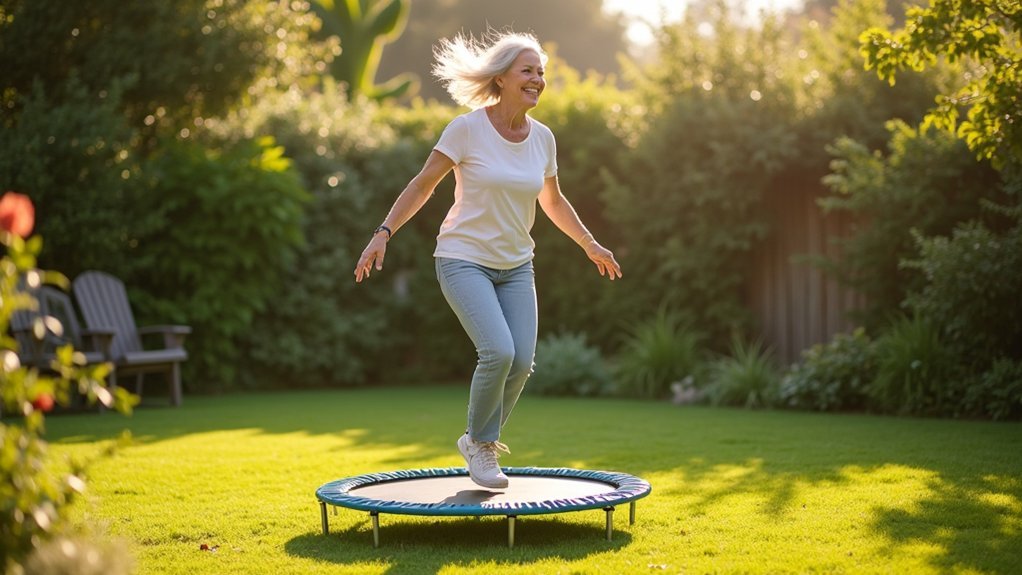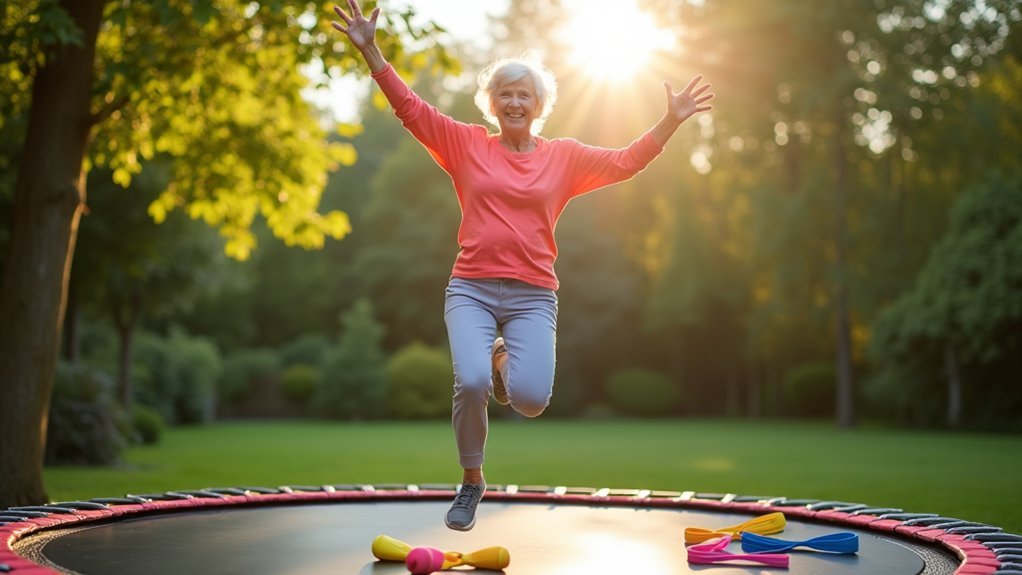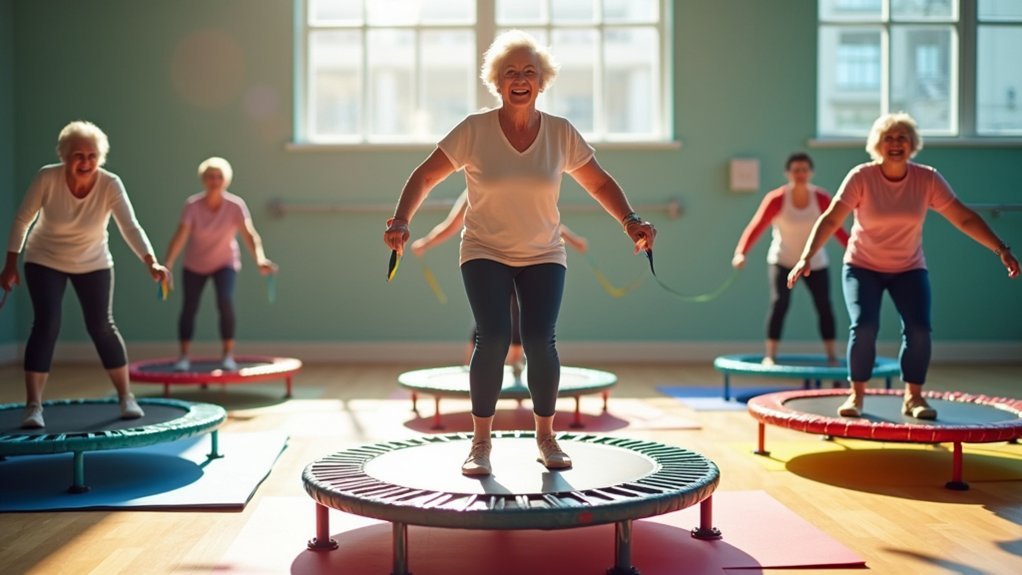Trampolines offer seniors gentle yet effective calorie-burning exercise through low-impact rebounding, continuous motion techniques, and seated options that protect joints. You’ll burn approximately 9.4 calories per minute while strengthening your core and improving balance. Upper body movements and interval training can amplify results without stressing knees or hips. Even balance exercises on trampolines activate 40% more core muscles than floor workouts. Discover how just 20-30 minutes, 3-4 times weekly can transform your fitness journey.
Low-Impact Rebounding: The Joint-Friendly Calorie Burner

The gentle bounce of a trampoline offers seniors a perfect balance between effective exercise and joint protection.
Unlike running or high-impact activities, rebounding minimizes stress on your knees and hips while still delivering impressive calorie-burning results.
You’ll burn approximately 9.4 calories per minute while rebounding—comparable to running but without the jarring impact.
For perspective, a 30-minute session can greatly contribute to your weight management goals while simultaneously improving your balance and coordination, reducing fall risks.
What makes rebounding particularly senior-friendly is your ability to control intensity.
You can start with gentle bounces and gradually increase your effort as your confidence grows.
The exercise also enhances lymphatic drainage, supporting overall health while you’re having fun getting fit.
A 150-pound senior who rebounds for 30 minutes will burn about 280 calories using the standard MET value of 7.2 for this exercise.
Continuous Motion Technique for Maximum Calorie Expenditure
Maintaining continuous motion on your trampoline greatly amplifies calorie burn while protecting your joints from excessive strain.
A 30-minute session can torch 150-240 calories, depending on your weight and intensity level.
To maximize benefits, incorporate varied movements like gentle twists, modified squats, or arm circles rather than pausing between jumps.
Try synchronizing your bounces with upbeat music to naturally increase your pace.
For even greater results, experiment with high-intensity intervals – alternate 30 seconds of vigorous bouncing with 90 seconds of gentle rebounding.
This exercise is particularly suitable for seniors as it offers low-impact cardiovascular benefits while being gentler on aging joints than many traditional workout options.
Upper Body Engagement to Amplify Your Trampoline Workout

While many seniors focus solely on leg movements during trampoline workouts, engaging your upper body can greatly boost calorie burning potential.
Simple modifications like arm raises during bounces or jumping jack variations can transform a basic session into a full-body experience.
Transform your trampoline workout by adding simple arm movements—turning a basic bounce session into complete body conditioning for seniors.
Try incorporating resistance bands for added upper body resistance, or challenge yourself with surf twists that engage your obliques while requiring arm coordination for balance.
For those with access to mini trampolines with handles, these provide excellent support while still allowing you to work your shoulders and arms.
Remember that involving your upper body not only increases calorie burn but also improves coordination and balance—crucial benefits for seniors.
Using light weights (3-5 lbs) for controlled movements like bicep curls and diagonal reaches can provide effective upper body activation while maintaining a basic bounce pattern.
Always warm up properly and listen to your body’s signals to guarantee safe, effective workouts.
Interval Bouncing: Alternating Intensity for Optimal Results
You’ll find greater calorie-burning potential by implementing the burn-rest-burn technique during your trampoline workouts.
Setting an intensity timer helps you alternate between high-energy bouncing and recovery periods, maximizing your metabolic benefits while preventing undue fatigue.
This interval approach is particularly valuable for seniors, as it allows you to challenge yourself safely while building stamina at your own pace. The process burns approximately 0.0613 calories per kg of body weight each minute during recreational jumping, making it an efficient exercise option.
Burn-Rest-Burn Technique
The Burn-Rest-Burn technique represents one of the most effective ways seniors can maximize calorie burn on a trampoline without overtaxing their bodies. This interval approach alternates between high-intensity bouncing and recovery periods, keeping your heart rate elevated while allowing necessary rest.
You’ll experience enhanced calorie burning as your metabolic rate increases during these strategic intervals. The technique engages your core and leg muscles while improving cardiovascular health and endurance. With an average of 9.4 calories per minute, rebounding offers seniors an efficient way to manage weight while being gentle on joints.
Try incorporating exercises like High Bounce for 30 seconds, followed by gentle Straight Jumps for recovery, then shift to more challenging Tuck Jumps as you build strength.
What makes this method particularly suitable for seniors is its adaptability—you can always modify intensity based on your fitness level and energy.
Remember to consult your healthcare provider before starting this routine.
Intensity Timer Benefits
Implementing an intensity timer for your trampoline workouts transforms ordinary bouncing into a calorie-burning powerhouse for seniors. The structure of 20-second work periods followed by 10-second rest intervals maximizes your calorie expenditure while preventing overexertion.
Try organizing your bounces into 4-minute blocks, completing 8 rounds to sustain elevated metabolism long after you’ve finished exercising. This proven method, known as Tabata Interval Training, was developed by Dr. Izumi Tabata specifically to boost both aerobic and anaerobic fitness simultaneously. You’ll find these portable timing frameworks easily adapt to your fitness level, whether you’re just starting out or more advanced.
The clear start/stop signals help you pace yourself properly, while the time-efficient format—as short as 4-minute micro-workouts—fits seamlessly into your daily routine.
This controlled interval approach guarantees you’ll maintain heart-healthy intensity without the joint stress of traditional exercises, making trampoline workouts both effective and sustainable.
Seated Rebounding Exercises That Still Torch Calories

Five effective seated rebounding exercises can help seniors burn significant calories without standing. You’ll still elevate your heart rate to 127-137 bpm while protecting your joints. Adding light weights during arm movements increases energy expenditure, while extending sessions to 40+ minutes compensates for reduced intensity. These seated exercises provide many of the same joyful benefits as standing routines while making fitness more accessible for seniors with mobility limitations.
| Exercise | Calorie Burn | Benefits |
|---|---|---|
| Seated Marching | 65-146 cal/30min | Maintains elevated heart rate |
| Weighted Arm Circles | 130-150 cal/30min | Engages upper body muscles |
| Torso Twists | 100-120 cal/30min | Activates core and obliques |
| “Speed Bag” Punches | 120-140 cal/30min | Emulates boxing movements |
| Resistance Band Pulls | 140-160 cal/30min | Amplifies muscle engagement |
Balance and Core Activation: The Hidden Calorie Burning Bonus
Your trampoline workouts engage core muscles far more intensely than traditional floor exercises, creating a metabolic boost that continues burning calories even after your session ends.
When you balance on the rebounding surface, your body activates up to 40% more core muscles while making countless micro-adjustments that demand significant energy. The afterburn effect continues your calorie expenditure long after you’ve finished your rebounding session.
These balance challenges not only improve your stability but also maximize calorie burn through neuromuscular responses that spike energy demands while keeping impact gentle on your joints.
Core Muscles Ignite Metabolism
When seniors bounce on trampolines, their core muscles spring into action, creating a hidden calorie-burning powerhouse that many don’t realize exists. Each bounce activates your abdominal, back, and pelvic muscles, laying the foundation for improved metabolism.
Your core muscles greatly impact your resting energy expenditure. By strengthening them through trampoline exercises, you’re building lean muscle mass that burns calories even when you’re relaxing. Trampoline exercises contribute significantly to nonexercise activity thermogenesis, adding to your daily caloric expenditure beyond structured workout sessions.
The continuous stabilization required during bouncing challenges your body’s balance systems, forcing your core to work overtime. This increased muscle engagement not only burns calories during your workout but continues afterward through excess post-exercise oxygen consumption (EPOC).
Over time, this core strengthening leads to lasting metabolic benefits, including enhanced insulin sensitivity and improved glucose metabolism—crucial advantages for seniors managing their weight and overall health.
Balance Workouts Maximize Effort
Balance workouts on trampolines offer seniors a hidden advantage that goes beyond simple bouncing. When you’re maintaining stability on a trampoline, your body constantly makes micro-adjustments that greatly increase caloric expenditure.
Your core muscles activate automatically during balance exercises, creating a powerful calorie-burning system as you work to stay steady. This low-impact activity burns calories comparable to moderate calisthenics—approximately 80 calories per 20 minutes for a 150-pound person. Research shows energy expenditure increases by 14.2% higher when actively engaging in balance training compared to sitting.
- Core activation improves posture and overall stability
- Variable intensity allows customization for different fitness levels
- Repeated stabilizing movements sustain energy use over time
- Heart rate elevates even during gentle balancing exercises
The beauty of trampoline balance work lies in its adaptability—you’ll gain injury prevention benefits while maximizing caloric burn through dynamic stability challenges.
Consistency and Duration: Setting a Sustainable Rebounding Routine
Establishing a consistent rebounding routine stands as the cornerstone of an effective trampoline exercise program for seniors. For ideal results, aim to bounce 3-4 times weekly for 20-38 minutes per session, depending on your fitness level.
Start with low-impact movements, gradually increasing intensity as your endurance builds. The beauty of rebounding lies in its joint-friendly nature while delivering calorie burn equivalent to running at 6 mph. Using a safety bar can provide additional balance support for beginners or those with mobility concerns.
You’ll experience improved cardiovascular health, better insulin function, and enhanced mood as your body releases happiness hormones during workouts.
Create a flexible schedule that works with your lifestyle, incorporating variety to prevent boredom. Remember to allow adequate recovery time between sessions, and consider consulting a fitness professional to tailor exercises to your specific needs and health conditions.
Frequently Asked Questions
How Many Calories Can Seniors Burn in a 20-Minute Trampoline Session?
You’ll burn approximately 100-200 calories in a 20-minute trampoline session, depending on your weight and intensity. Lighter movements yield lower results, while more vigorous bouncing increases your calorie burn considerably.
Can Trampolining Help With Arthritis Pain While Burning Calories?
Yes, trampolining can help ease your arthritis pain while burning calories. It’s low-impact on joints, promotes gentle movement, and releases stress-reducing hormones. You’ll also strengthen muscles that support painful joints.
Are Mini-Trampolines Safe for Seniors With Osteoporosis?
Mini-trampolines aren’t safe if you have osteoporosis. They pose significant fall risks and can stress your fragile bones. Instead, you’ll benefit more from low-impact activities like walking, yoga, or Pilates for bone health.
How Does Rebounding Compare to Swimming for Calorie Expenditure?
You’ll burn similar calories with rebounding and swimming. Both reach 10-12 calories per minute, but rebounding often provides better afterburn effects, extending your calorie expenditure beyond the actual workout session.
Should Seniors Wear Special Footwear When Using a Trampoline?
Yes, you should wear supportive footwear when using a trampoline as a senior. Cross-training shoes provide ankle support, reduce slipping risks, and offer cushioning that protects your joints while maintaining stability during bouncing exercises.
In Summary
You’ve discovered that trampolines aren’t just for kids—they’re your gateway to effective, joint-friendly fitness. Whether you’re seated rebounding or practicing intervals, you’re burning calories while protecting your body. Don’t worry about intensity; consistency matters most. As you incorporate these seven techniques into your routine, you’ll enjoy improved balance, stronger muscles, and increased energy. Start slowly, bounce regularly, and watch your fitness soar.





Leave a Reply